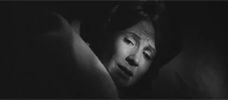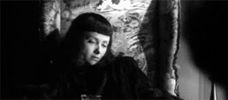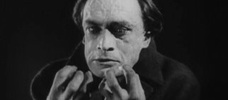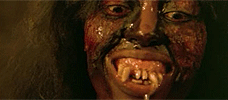Reviews
Charles Martin Smith
USA, 1986
Credits
Review by David Carter
Posted on 18 October 2009
Source VHS
Categories 31 Days of Horror VI
Trick or Treat begins with one of the more effective introductions in the eighties horror canon. After a quote from Goethe’s Faust, we hear the inner monologue of Eddie as he writes a fan letter to his shock rock idol, Sammi Curr. In it Eddie laments the state of his life and expresses suicidal thoughts (we can tell this is not the first such letter he’s written to Curr) before signing it “Ragman.” As soon as his fan letter is finished, we are shown that Eddie wasn’t exaggerating his troubles: a slow-motion montage displays the horrible cruelty visited upon him by his peers, specifically by school bully Tim, who takes a perverse pleasure in tormenting Eddie for simply being a “metal head.” The montage culminates with Tim shoving a nude Eddie onto the floor of the girls’ gymnasium to a chorus of laughs and, most upsettingly, in front of the girl he loves, Leslie.
This opening sequence efficiently engenders sympathy for Eddie and introduces all of the main characters. Most importantly, it establishes Eddie’s role as outsider in his community, ostensibly because of his metal head clothing and attitude. What Trick or Treat doesn’t fully divulge in this preface is something that remainder of the film alludes to frequently: that Eddie is also ostracized because he is Jewish.
Though it is never overtly mentioned, a claim that Trick or Treat is more about Jewish persecution than about metal head persecution is not without evidence. Eddie’s last name is Weinbauer, something only revealed when blonde-haired, blue-eyed Tim derisively calls him that. A shared faith and culture would explain Eddie’s friendship with the nerdy Roger, a teen with whom Eddie has little in common. Additionally, Eddie is played by Marc Price, best known as “Skippy” on the television hit Family Ties, himself Jewish. The unexplained use of the nickname “Ragman” could possibly be an allusion to a short-lived DC Comics Jewish superhero of the same name. Furthermore, the Ragman character was a variation on the Jewish legend of the Golem, from which Trick or Treat borrows heavily.
Before mailing his letter, Eddie sees a news broadcast announcing Sammi Curr’s death in a hotel fire. He vents his feelings to local disc jockey Nuke, who gives him the acetate master of Curr’s not-yet-released album to help him grieve. Eddie believes that the album is speaking to him through backward-masked messages, the first of which he deciphers to be “Let the big fish hook themselves.” He takes Curr’s advice, getting the best of Tim for the first time. As he listens to the album more and more, he finds that the messages aren’t in the songs but are coming directly from Curr from beyond the grave. With each play Curr’s power grows stronger, causing the timid Eddie to rebel against his idol and refuse to do his bidding. The electric form of Curr emerges from the speakers before the record can be destroyed, however, and begins wreaking havoc in the real world.
The similarities between Trick or Treat and Paul Wegener’s Der Golem films are immediately evident. Both works feature a Jew subjected to persecution by his community who summons a mystical creature for self-protection, one that ultimately becomes too powerful and destructive to control. It is suggested in the film that Curr died performing a magic ritual in Germany, also the setting of Der Golem. Both Eddie and Curr fill the Golem role in the film, with Eddie at first simply being possessed by Curr’s spirit and standing up for himself for the first time. Eddie’s victories are presented both with comic excess and huge emotional weight: having established the direness of his situation early on, viewers will celebrate Eddie’s triumphs with him. Conversely, our identification with him makes it all the more poignant when things take a nightmarish turn.
Curr shows his true motives when he is manifested in Tim’s car and attacks his girlfriend. A shocked Tim accuses Eddie of witchcraft, an allusion to the blood libel used in anti-Jewish propaganda for centuries. Trick or Treat depicts Eddie as a true hero without any malicious intent so he immediately sets out to stop Curr once he becomes destructive. It is at this point that Curr becomes the Golem/Frankenstein’s Monster of the film until Eddie is able to defeat him by stating that he no longer idolizes him, which has the effect of removing his “star of power” or life-giving force.
Trick or Treat is a hard rock horror film and it incorporates the music, attitudes and dress of the eighties hard rock scene far better than any of its contemporaries. Eddie’s taste in music – with the exception of the fictional Curr – is made up of highly regarded metal bands such as Iron Maiden and Judas Priest, so the references in the film have a much longer shelf life than is typical of a hard rock horror film. In what has long been Trick or Treat ‘s claim to fame, rockers Gene Simmons and Ozzy Osbourne have brief cameos, with Osbourne poking fun at his critics in a role as an anti-rock crusading minister.
The character of Sammi Curr is a mixture of Alice Cooper and WASP frontman Blackie Lawless, but the group Fastway provides his music. Formed by former Motorhead guitarist “Fast” Eddie Clarke, Fastway was something of a heavy metal/hard rock supergroup, featuring former members of UFO and Humble Pie on bass and drums respectively. Irish born vocalist Dave King would go on to form punk band Flogging Molly and is the voice behind Curr during his murderous rendition of the band’s hit “Trick or Treat.” “Trick or Treat” and the other songs on the soundtrack are all short, catchy metal songs that sound little like the other bands of Fastway’s members, but are incredibly memorable and make Trick or Treat’s soundtrack one of the better single-band efforts of the ’80s, regardless of genre.
Trick or Treat’s tale of an outsider who abandons his quest for revenge to become a hero, not to mention the veiled allusions to Jewish persecution, is far more resonant than is typically found in the horror genre. At times it flirts with ideas and ironic gags not dissimilar to the A Nightmare on Elm Street franchise, but the ultimate message of the film is delivered with the utmost sincerity, something not often seen in more successful horror films of the period. Trick or Treat praises the power and potential of the persecuted, be they Jew, metal head or simply social outcasts — those who choose humanity over revenge.
More 31 Days of Horror VI
-

From Beyond
1986 -

The Haunting
1963 -

Killer Klowns from Outer Space
1988 -

Shock ‘Em Dead
1991 -

Critters
1986 -

Critters 2
1988 -

The Fall of the House of Usher
1928 -

Jonestown: The Life and Death of Peoples Temple
2006 -

In the Mouth of Madness
1994 -

Winterbeast
1991 -

Black Roses
1988 -

Needful Things
1993 -

The Seventh Victim
1943 -

A Page of Madness
1926 -

Holocaust 2000
1977 -

The Man and the Monster
1958 -

The Texas Chainsaw Massacre 2
1986 -

Trick or Treat
1986 -

Single White Female
1992 -

Trouble Every Day
2001 -

The Hands of Orlac
1924 -

The Devil’s Advocate
1997 -

Nocturne
1998 -

Hardware
1990 -

Hard Rock Zombies
1985 -

The Slumber Party Massacre
1982 -

Saw VI
2009 -

Zombi 4: After Death
1988 -

The Uninvited
1944 -

Hausu
1977
We don’t do comments anymore, but you may contact us here or find us on Twitter or Facebook.



